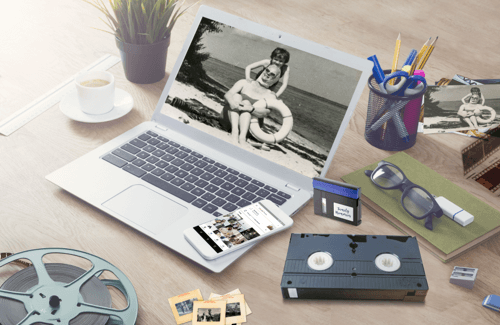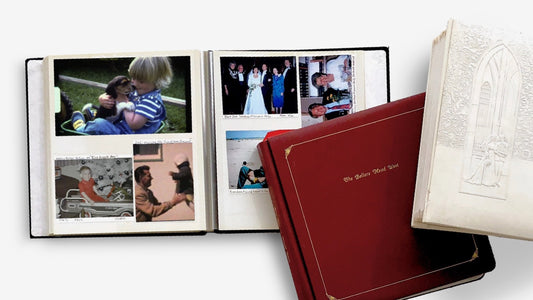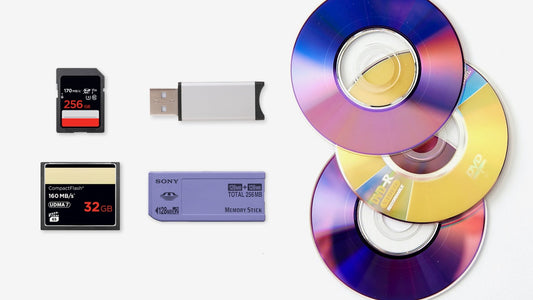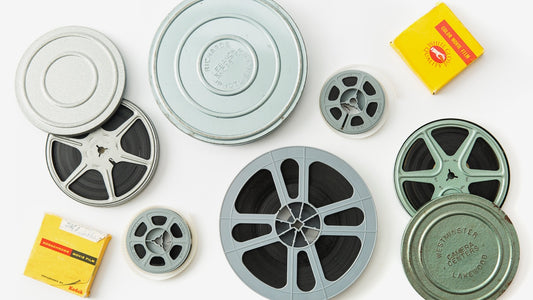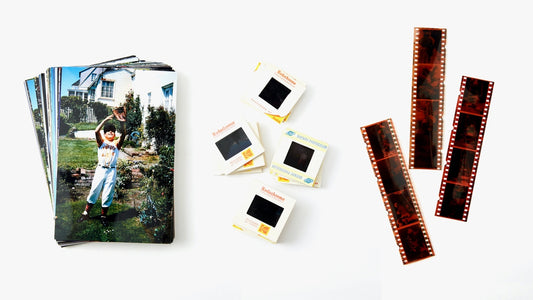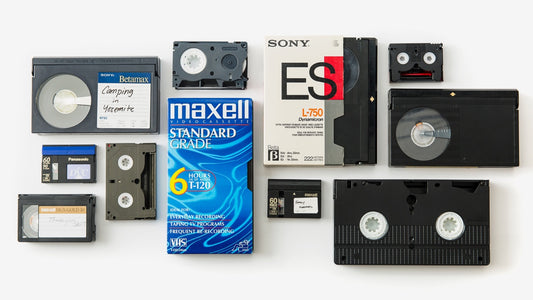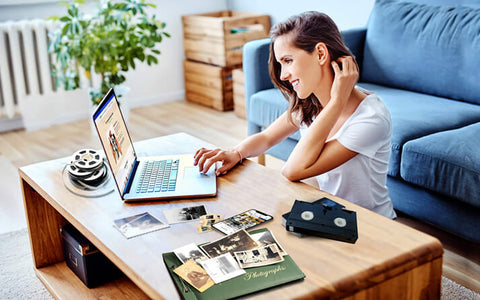Are those boxes of VHS tapes in your closet more than just clutter? They're a treasure trove of memories, but time isn't on their side. Tapes degrade, and finding a working VCR is getting harder every year. This guide simplifies the entire process of using a VHS to DVD converter to save those precious moments before they fade. We'll walk through different vhs video to dvd converter options, highlight the key features to look for, and share practical tips to handle any challenges. It's time to preserve your home movies so they can be enjoyed for generations.
Key Takeaways
- Protect those precious home movies: VHS tapes deteriorate over time. Converting them to digital or DVD format preserves your memories and makes sharing easier. YesVideo offers professional, high-quality transfers for a hassle-free experience.
- DIY or professional services—choose wisely: Converting tapes yourself can be technically challenging and time-consuming. Consider your comfort level with technology and the value of your time when deciding between DIY and professional services like YesVideo.
- Digital and cloud storage offer the best long-term protection: Don't rely solely on DVDs. Digital files stored on USB drives, external hard drives, or in the cloud provide greater accessibility and safeguard your memories from physical damage. Explore these options to ensure your home movies are safe and easily shared for generations.
What is a VHS to DVD Converter?
A VHS to DVD converter helps you transfer those precious memories trapped on your old VHS tapes into digital files, typically DVD format. Think of it as a bridge between outdated technology and today's devices. This process is key for preserving those irreplaceable moments, as VHS tapes can degrade over time, losing picture and sound quality. Plus, who even has a working VCR these days?
These converters come in a few different forms. You can find standalone devices that combine a VCR and DVD recorder all in one—handy because they handle the entire process internally. Alternatively, there's software that works with your computer and some additional hardware. This usually involves connecting your VCR to your computer with a capture device. Both options essentially capture the analog video and audio from your VHS tapes and convert them into digital files that you can then burn onto a DVD. This not only safeguards your memories but also makes them much easier to share—no more bulky tapes! You can even upload your digitized videos to online storage or cloud-based solutions for safekeeping and easy access. Services like YesVideo specialize in this type of conversion, handling everything for you.
The Growing Demand for VHS Conversion
If you have a box of home movies on VHS, you might be surprised to learn they have a limited shelf life. The magnetic tape inside them starts to break down after about 15 years, which means the picture and sound quality can fade, warp, or disappear entirely. This physical decay is a major reason so many people are now looking for ways to convert their tapes. It’s not just about decluttering the attic; it’s about making sure those irreplaceable memories—like first steps, family holidays, and weddings—don't vanish along with an outdated technology. The urgency is real, as every passing year puts those moments at greater risk.
This need to preserve memories has created a strong demand for conversion solutions. While some people explore DIY options by purchasing converter machines, the process can be technically challenging and time-consuming. For those who want to ensure a high-quality result without the hassle, professional services are a popular and often safer choice. Companies that specialize in video transfer handle the entire process for you, using professional-grade equipment to safely digitize your tapes. Considering how fragile old tapes can be, trusting experts is a reliable way to protect your family’s history for future generations to enjoy on modern devices.
Why You Should Convert Your VHS Tapes to DVD
Do you have boxes of old VHS tapes gathering dust in the attic? Those precious home movies, family gatherings, and once-in-a-lifetime events are trapped on a format that's becoming increasingly obsolete. It's time to breathe new life into those memories and safeguard them for future generations. Here's why converting your VHS tapes to DVDs is so important:
Time takes its toll on everything, and VHS tapes are no exception. They degrade over time, losing picture quality and becoming prone to damage from humidity, temperature changes, and even just playing them too many times. Converting your tapes to DVDs helps preserve these memories before they're lost forever. Think of it as giving your memories a fresh start. Plus, you'll be able to easily share these digitized memories with family and friends, ensuring they're enjoyed for years to come.
You might be surprised at how much better your old videos can look. Many VHS tapes simply don't look as good as they did when they were new. Converting to DVD can often improve the video quality, resulting in a clearer, more vibrant viewing experience. You'll rediscover details you may have forgotten were there. This improved quality makes it even more enjoyable to relive those special moments.
Unlike VHS tapes, which can be easily damaged or become unplayable due to wear and tear, DVDs offer greater durability and longevity. Switching to digital protects your videos from physical damage and ensures they remain accessible for years to come. You won't have to worry about your VCR breaking down or your precious tapes becoming unwatchable.
Remember those frustrating tracking issues and flickering images that sometimes plagued VHS tapes? Converting to DVD helps eliminate these problems, providing a smoother, more enjoyable viewing experience. Addressing these common VHS issues ensures that your memories are preserved in the best possible quality. You'll finally be able to watch your videos without those annoying interruptions.
The Limited Lifespan of VHS Tapes
Magnetic tapes were never meant to last forever. The reality is that VHS tapes have a limited lifespan and begin to degrade after about 10 to 25 years, even under ideal conditions. The magnetic particles that store your video information can lose their charge, leading to faded colors, distorted sound, and a snowy picture. Environmental factors like humidity and temperature fluctuations can speed up this decay, causing the tape to become brittle or moldy. Even the simple act of playing a tape causes wear and tear on its delicate surface. Every time you watch that wedding video or your child's first steps, you're contributing to its slow decline. Converting your tapes is the only way to stop this process and preserve these memories before they fade away completely.
The Disappearing VCR Player
Even if your tapes are in perfect condition, you face another major hurdle: finding a reliable VCR to play them on. The last VCR was manufactured in 2016, which means any player you find today is either used or refurbished. These older machines can be unpredictable and may even damage your irreplaceable tapes by eating them or tangling the film. Relying on aging hardware is a risky bet for your most precious memories. Instead of hunting for outdated equipment, consider a permanent solution. A professional video transfer service uses well-maintained, high-quality equipment to safely digitize your tapes, ensuring your home movies are protected and can be enjoyed on any modern device without the need for a VCR.
What to Look For in a VHS to DVD Converter
Before you dust off those treasured VHS tapes, let's talk about what to look for in a VHS to DVD converter. Whether you're using a standalone device or software, certain features are key to getting the best possible digital copies of your home movies.
Checking for High-Quality Video and Resolution
Video quality is everything when converting VHS tapes to digital. Remember, we're dealing with older technology, and issues like tracking problems are common. A good converter will allow you to adjust tracking settings to improve clarity and ideally offer different output resolutions. This lets you choose the best balance between file size and picture quality. If you’re looking for top-notch quality, consider sending your tapes to a professional service like YesVideo. Our experts handle these issues, ensuring your memories are preserved beautifully. Learn more about our video transfer services.
Finding a User-Friendly Interface
Nobody wants to wrestle with complicated software or clunky hardware. Look for a converter with a user-friendly interface that simplifies the process. If you find yourself struggling with complicated menus or confusing instructions, consider a different option. Sometimes, the simplest solution is the best, and that might mean choosing a service that handles everything for you.
Ensuring Format Compatibility
Not all VHS tapes are created equal. Some might have quirks or be in slightly different formats. A reliable converter should handle a variety of formats seamlessly. This compatibility ensures a smoother transfer process and minimizes the risk of unexpected problems. YesVideo’s professional transfer service handles a wide range of formats, taking the guesswork out of the equation. Check out our services.
Bonus Features That Make a Difference
Beyond the basics, some converters offer extra features that can be incredibly helpful. Things like built-in troubleshooting tools, noise reduction, or basic editing capabilities can significantly improve the final product. Think about what's important to you and choose a converter that meets those needs.
Do You Need Editing Capabilities?
While not strictly part of the conversion process itself, having some basic editing capabilities can be a huge plus. This allows you to trim unwanted footage, fix minor color issues, or even add transitions between clips. If you're planning more extensive edits, dedicated video editing software might be a good investment, but having a few basic tools built into your converter can save you time.
My Top Picks for VHS to DVD Converters
Ready to convert those dusty VHS tapes to a more modern format? Choosing the right converter can feel overwhelming with so many options available. This section breaks down some popular choices, from DIY devices to professional services, to help you find the perfect fit.
Best Professional Service: YesVideo
If hands-off convenience and top-notch quality are your priorities, consider a professional service like YesVideo. We handle everything for you, from start to finish. Just send us your tapes, and we'll return them along with your new digital files or DVDs. YesVideo offers a quick turnaround time, typically completing orders within 30 days, and guarantees 100% satisfaction.
Best for Mac Users: Elgato Video Capture
For a DIY approach, the Elgato Video Capture device is a popular choice. Known for its user-friendly software and high-quality video capture, it's a solid option for Mac and Windows users. You'll need a computer with a USB port, but the Elgato makes the process relatively straightforward.
Best for PC Users: Diamond VC500
The Diamond VC500 is another good option for DIY converters. It's compatible with various operating systems and offers a simple setup. While not as feature-rich as the Elgato, it's a reliable choice for basic VHS to DVD conversion. You can find this device, and others like it, on Amazon.
Best All-in-One Software: Roxio Easy VHS to DVD 3 Plus
The Roxio Easy VHS to DVD 3 Plus bundle provides a comprehensive solution. It includes software and hardware for capturing video from various analog sources, including VHS tapes. The software also offers basic editing capabilities, allowing you to trim footage or add transitions. Check out Roxio's website for the latest version of their software.
Easiest Standalone Option: ClearClick Video to Digital Converter
Want to digitize your tapes without a computer? The ClearClick Video to Digital Converter is a standalone device that records video directly to a USB flash drive or SD card. It's a great option for those who want a simple, no-fuss solution. You can typically find ClearClick products on major online retailers.
The All-in-One Combo Player: LG DVD/VHS
If you're looking for an all-in-one solution, an LG DVD/VHS Combo Player might be a good fit. These players allow you to play both DVDs and VHS tapes, and some models offer the ability to dub VHS tapes directly to DVD. It's a convenient option for consolidating your media setup. Best Buy is a good place to start your search for combo players.
A Solid Budget-Friendly Choice: Portta Digital Converter
For those on a budget, the Portta Digital Converter offers a more affordable way to convert VHS tapes to digital formats. While it may not offer the same level of quality as higher-end devices, it's a decent option for basic conversions. You can often find budget-friendly electronics on sites like eBay.
How Much Do VHS to DVD Converters Cost?
So, you’re ready to convert those precious VHS tapes to DVD. But how much will it set you back? Understanding the costs is a smart first step. Let’s break down the price ranges for VHS to DVD converters and explore some ways to find the best deals.
What to Expect to Pay
When it comes to VHS to DVD converter hardware, you'll find a pretty wide range of prices—typically starting around $13 and going all the way up to over $300. Amazon offers a good overview of the various options. This price difference usually comes down to the features offered. A basic converter might do the job, but pricier models often include extra perks like multiple input types, higher video quality, and the ability to convert to digital formats beyond just DVD.
If you're not tech-savvy, or just prefer a hassle-free experience, consider professional conversion services like Legacybox, which offers competitive pricing starting as low as $9 per VHS tape for conversion to DVD or digital files, especially if you have a lot of tapes to convert. CVS also provides conversion services, with prices starting at $25.99 for VHS to DVD. The final price will depend on the specific format and how much media you need converted.
Breaking Down Professional Service Costs
If the DIY route feels a bit daunting, professional services are a fantastic alternative. They take the technical guesswork out of the equation and handle your precious memories with expert care. When you look at the costs, you'll find a few different models. For example, a service like Legacybox offers pricing that can be as low as $9 per tape, which is great if you have a large collection. Here at YesVideo, we offer a complete service where you just send in your tapes, and we handle the rest, typically within 30 days and with a 100% satisfaction guarantee. You can also find options at retail stores; for instance, CVS offers conversion services starting at $25.99. The final cost often depends on the format and quantity, so it’s always a good idea to compare to see what works best for your budget and needs.
How to Find Deals and Discounts
Everyone loves a good deal! If you’re looking to save money on your VHS conversion project, keep an eye out for promotions. Legacybox frequently runs special offers and discounts, sometimes with rates as low as $9 per tape—a significant drop from their regular price. They also offer various packages, so checking their website for current promotions is always a good idea. Also, keep an eye on retailers like CVS Photo, which often have sales on photo services, sometimes including video transfers. A little research can go a long way in helping you find the most cost-effective solution for preserving your memories.
DIY or Professional Service: Which Is Right for You?
When it comes to converting your VHS tapes to DVD, you have two main paths: doing it yourself (DIY) or using a professional service. Both have their own set of advantages and disadvantages, so let's weigh them to help you make the best decision for your precious memories.
The Pros and Cons of Going DIY
The most appealing aspect of DIY conversion is the perceived cost savings. It seems simple enough to buy a VHS player and DVD recorder to transfer your tapes yourself. Some recommend finding a used VCR/DVD combo unit on sites like eBay or Craigslist. This sounds simple, but the reality can be more complicated. Finding a reliable combo unit can be tricky, and the quality might not be up to par. The cost of equipment like blank DVDs and the necessary cables adds up quickly. You might spend upwards of $250 on a working combo player, with the total cost potentially exceeding $1000. Beyond the financial investment, DIY conversion requires a significant time commitment and technical skill. There’s also the risk of damaging your irreplaceable memories during the transfer process.
Potential for Lower Quality Results
One of the biggest risks with a DIY approach is ending up with a low-quality digital copy. Consumer-grade capture cards and combo players often lack the sophisticated technology to handle the quirks of old VHS tapes. You might encounter issues like poor color, audio sync problems, or what some users describe as "horrible quality" results. These devices typically don't allow for fine-tuning adjustments, like tracking, which is crucial for getting a clear picture from a degraded tape. In contrast, professional services use commercial-grade equipment and have technicians who can manually optimize the transfer for each tape. If you're looking for top-notch quality, it's worth considering a service that can transfer your videos professionally. After all, the goal is to preserve these memories in the best possible way, not just create a pixelated version of them.
When to Use a Professional Service
Professional services like YesVideo take the hassle and risk out of VHS conversion. With YesVideo, you don’t have to worry about tracking down equipment, figuring out complicated software, or spending hours transferring tapes. We handle everything for you, from sending you a secure shipping kit to carefully handling your original tapes and returning them safely. YesVideo uses a hand-digitizing process, ensuring the highest quality transfer for your precious memories. Our video transfer service offers competitive pricing and bulk discounts, making it a cost-effective solution, especially when you consider the time and potential expense of the DIY route. With YesVideo, you get the peace of mind that comes with over 20 years of experience and a commitment to quality. We've served countless families, helping them preserve their memories for generations to come. All our work is done by hand in the USA.
Comparing Popular Conversion Services
When you decide to hand over your precious memories, you want a service you can trust. For a completely hands-off experience that prioritizes quality, a professional service like YesVideo is an excellent choice. We manage the entire process for you; simply send in your tapes, and we’ll return them along with your newly digitized memories. Another popular option is Legacybox, which uses a kit-based system to help you digitize various media types, including VHS, MiniDV, and Hi8 tapes. While both services offer convenience, YesVideo has over 20 years of experience, with every order processed by hand in the USA, ensuring your home movies receive the care they deserve.
What to Expect from a Service
Using a professional service removes all the technical guesswork and time commitment from the conversion process. You won’t need to buy any equipment, install software, or spend hours monitoring transfers. With a service like YesVideo, the process is simple. We send you a secure, crush-proof box to pack your media. Once we receive it, our technicians carefully digitize each tape by hand. You’ll get your original tapes back, plus your choice of DVDs or a digital copy available through a MemoryCloud account for easy viewing and sharing. Other services, like Legacybox, offer different kit sizes and deliver your digital files on a thumb drive, cloud storage, or DVDs, giving you flexibility in how you receive your memories.
Handling Multiple Tape Formats
Chances are, your home movie collection isn't just one type of tape. You might have a mix of standard VHS, smaller VHS-C tapes from a camcorder, and maybe even some Hi8 or MiniDV tapes. A major benefit of using a professional service is their ability to handle this variety. Instead of you needing different equipment for each format, a reliable service can convert them all in one go. At YesVideo, we handle a wide range of formats, from videotapes and film reels to photos and slides. This compatibility ensures a smooth process, saving you the headache of sorting and sending your memories to multiple places.
How to Use a VHS to DVD Converter: A Step-by-Step Guide
Transferring your treasured memories from VHS to DVD might seem daunting, but with the right tools and a little guidance, it's a manageable project. This step-by-step guide will walk you through the process:
Gather your equipment. You'll need your VHS player, the VHS to DVD converter, the necessary cables (usually RCA cables), and a computer with the appropriate software. Make sure you have the correct cables to connect everything.
Connect your devices. Connect your VHS player to the converter using the RCA cables. Then, connect the converter to your computer, typically via USB. Double-check that all connections are secure.
Prepare your VHS tapes. Before you start, it's a good idea to clean your VHS tapes to ensure the best possible transfer quality. A VHS head cleaner can help remove dust and debris that can affect playback. Also, adjust the tracking on your VCR. This often-overlooked step can significantly improve the final video quality.
Install and launch the software. Most converters come with software to facilitate the transfer. Install this software on your computer and launch it.
Start capturing. Follow the software prompts to begin capturing the video from your VHS tape. You'll likely have options to select input sources, recording quality, and other settings.
Monitor the transfer. Keep an eye on the process to ensure everything is running smoothly. You might see a preview of the video being captured in the software window.
Edit (optional). Some software allows for basic editing, like trimming the beginning or end of the video. If you want to make more extensive edits, you can save the captured video and use a separate video editing program.
Finalize and burn. Once you're happy with the captured video, follow the software's instructions to finalize and burn it onto a DVD. This process creates a playable DVD that you can watch on most standard DVD players. Make sure you have blank, DVD-R discs on hand.
Test your DVD. After the burning process is complete, test the DVD in a regular DVD player to make sure it plays correctly.
While these steps provide a general overview, always refer to the specific instructions that came with your VHS to DVD converter and software for the most accurate guidance. If you're uncomfortable with the technical aspects or want to ensure the highest quality transfer, consider YesVideo's professional video transfer services. We handle everything for you, from start to finish, so you can relax and enjoy your memories.
Using a Standalone DVD Recorder
If you prefer a more direct approach without involving a computer, a standalone DVD recorder or a VCR/DVD combo unit can be a great option. These devices are designed to make the transfer process straightforward by recording directly from the VHS tape to a blank DVD. However, there are a few key settings you’ll want to get right to ensure your home movies look their best.
Choosing the Right Recording Quality
Your DVD recorder will likely offer several recording modes, which control the balance between video quality and how much footage you can fit on a single disc. The highest quality setting, often called XP mode, will give you the sharpest picture but typically only allows for about an hour of recording. For most VHS tapes, the SP (Standard Play) mode is the sweet spot. It provides good quality and lets you record for about two hours, which is perfect for the length of a standard tape.
Matching the Aspect Ratio
Here’s a technical tip that makes a big difference: make sure your DVD recorder is set to a 4x3 aspect ratio. This is the original, boxy screen shape that your VHS home movies were recorded in. Recording in this format ensures the picture doesn’t get stretched or distorted to fit modern widescreen TVs, preserving the authentic look of your memories. Check your recorder’s settings menu to confirm it’s set correctly before you hit record.
Finalizing Your DVD
This is the most important and most-often-missed step. After you’ve finished recording your VHS tape onto the DVD, you must “finalize” the disc. This process closes out the recording session and makes the DVD playable in other devices, like your computer or another DVD player. You can usually find this option in the recorder’s main menu. If you skip this, your newly created DVD will likely only work in the machine that recorded it. If managing recording modes and finalizing discs sounds like a headache, services like YesVideo handle all the technical details for you.
Using a Computer and Capture Card
For more control and flexibility, using a computer with a video capture card is the way to go. This method converts your VHS tape into a digital file on your computer first, which you can then edit, save to a hard drive, or burn to a DVD. It’s a few more steps, but it gives you a versatile digital copy of your memories that isn’t tied to a physical disc.
Choosing Your Capture Software
Once you have your VCR connected to your computer via a capture device, you’ll need software to record the video feed. Many capture cards come with their own software, but there are also excellent free options available. A popular choice is OBS Studio, which is powerful and relatively easy to use for recording video from an external source. This software is what will create the digital video file from your tape.
Burning a Playable DVD
After you’ve captured your home movie and saved it as a video file on your computer, the final step is to burn it onto a blank DVD. You’ll need DVD authoring or burning software for this—your computer’s operating system may even have a basic version built-in. This software takes your digital file and formats it correctly so that it will be recognized and played by a standard DVD player. Simply dragging the video file onto a blank disc won’t work, so be sure to use a proper burning program to create your final, playable DVD.
How to Fix Common Conversion Problems
So, you've started transferring your old VHS tapes, and you've hit a snag. Don't worry, it happens! Digitizing old tapes can be tricky, but many common issues are easily solved. Let's walk through some troubleshooting tips for common problems.
Fixing Poor Video Quality
One of the most frequent complaints when converting VHS tapes is poor video quality. This often boils down to tracking problems with your VCR. Remember how you used to have to adjust the tracking dial to get a clear picture? The same principle applies here. Try adjusting the tracking on your VCR while the tape is playing. Even small adjustments can make a big difference in the quality of your digital conversion. If your VCR has a built-in line-TBC (Time Base Corrector), enabling it can also improve video stability and reduce distortions. For particularly stubborn tracking issues, consider using a video stabilizer during the transfer process.
Solving Audio Sync Issues
Another common issue is audio that doesn't quite match up with the video. It's incredibly distracting to watch a video where the audio is slightly off. If you notice audio sync problems after your VHS to digital conversion, use video editing software to realign the audio and video tracks. Most editing programs have simple tools to correct this, creating a much smoother viewing experience. Sometimes, audio sync issues can arise from using incorrect cables or settings during the transfer process. Double-check your connections and make sure your capture device is configured correctly.
Dealing with Software Conflicts
Sometimes, the problem isn't your hardware, but the software you're using to capture the video. If you're experiencing problems with your current conversion software, try a different program. Different software programs handle video capture differently, and one that's better suited to your hardware setup might solve your compatibility issues. Check online forums and reviews to see what other users recommend. Make sure your software is up-to-date, as older versions may have compatibility issues with newer operating systems. Consider using OBS Studio, a free and open-source software for video recording and live streaming, as a versatile option for capturing video from various sources.
How to Stop Video Flickering and Tracking Errors
Tracking problems and flickering images can plague VHS transfers. These issues often stem from the age of the tapes or the VCR itself. Adjusting the tracking control on your VCR can sometimes resolve these problems. If that doesn't work, consider using a higher-quality VHS to DVD converter designed to handle the quirks of older tapes. Sometimes, a professional service like YesVideo is the best option for tapes with significant tracking or flickering issues. Our technicians have the expertise and equipment to get the best possible transfer from even the most challenging tapes. Check out our video transfer services for more information. Properly cleaning your VHS heads can also help minimize tracking and flickering issues. Use a VHS head cleaner to remove dust and debris that can interfere with the signal.
Beyond DVDs: How to Future-Proof Your Memories
While DVDs offer a physical backup of your memories, they aren’t immune to scratches, wear, and tear. Plus, technology changes. DVD players are becoming less common. Think about how easily you access videos on your phone or computer—that kind of convenience is what you want for your precious memories, too. So, let’s explore some ways to preserve your memories beyond just DVD conversion.
Exploring Your Digital Storage Options
Think of converting your old videos as digitizing them, much like scanning old photos. You get files you can store in multiple places. Services like YesVideo can transfer your videos to digital files, which you can then keep on a USB drive or external hard drive. This gives you a readily accessible copy of your videos that you can easily share with family and friends.
Using the Cloud to Save Your Videos
Cloud storage offers another layer of protection and accessibility for your digitized videos. Think of it as an extra backup that’s safe from physical damage. Services like Legacybox offer cloud storage as a way to preserve your converted videos, letting you access them from anywhere and easily share them with loved ones. This also ensures your memories are safe even if something happens to your physical storage devices.
How to Choose the Right Converter for You
Picking the right VHS to DVD converter depends on a few factors, like your tech skills, budget, and how many tapes you're converting. Let's break down what to consider:
First, consider your comfort level with technology. Do you enjoy working with gadgets and software, or would you rather leave the technical aspects to someone else? If you're comfortable with a little DIY, a standalone VHS to DVD recorder or a computer-based converter might be a good fit. Prices typically range from around $13 for basic software to over $300 for combination units. Combo units are handy because they have both VHS and DVD players built-in, simplifying the transfer process.
If you prefer a hands-off approach, consider a professional service like YesVideo. We handle video transfers, taking care of everything so you can relax knowing your memories are preserved in high quality. This is an excellent choice if you have many tapes or delicate film that needs careful handling. Legacybox offers similar services.
Next, think about the final video quality. While some converters promise easy one-click transfers, the actual quality can differ based on the condition of your tapes and the settings you choose. If your tapes are old or damaged, a professional service might be the best way to get the clearest transfers. If you're converting tapes yourself, remember that adjusting the tracking settings on your VCR can significantly impact the final video quality. This troubleshooting guide offers helpful tips for improving your results.
Finally, consider what you want to do with your digitized videos. If you simply want to watch them on a DVD player, a standard DVD converter is sufficient. If you want to share videos online or save them to a USB drive, look for a converter with those features. Some converters even offer basic editing tools for trimming footage or adding titles. Keep your long-term plans in mind when making your decision.
Related Articles
Frequently Asked Questions
Why are my old VHS tapes so important to convert? VHS tapes degrade over time, losing picture and sound quality. Converting them to a digital format like DVDs or digital files preserves your memories before they're lost forever. Plus, it makes them much easier to share with family and friends.
What's the difference between using a VHS to DVD converter myself and using a professional service? Doing it yourself can seem cheaper initially, but it requires technical know-how, time, and the right equipment. Professional services like YesVideo handle everything for you, ensuring high-quality transfers without the hassle. They also handle various formats and can address issues like tracking problems that are common with older tapes.
What if my VHS tapes have tracking problems or other quality issues? Adjusting the tracking on your VCR can often improve video quality during conversion. Professional services like YesVideo have the expertise and equipment to handle these issues and get the best possible transfer, even from damaged tapes.
What are my options beyond simply converting VHS tapes to DVDs? DVDs are a good start, but digital files offer more flexibility. You can store them on USB drives, external hard drives, or use cloud-based storage for easy access and sharing. Cloud storage also provides an extra layer of security against physical damage or loss.
What should I look for when choosing a VHS to DVD converter? Consider your technical skills, budget, and the number of tapes you need to convert. If you're comfortable with technology, a standalone converter or computer software might work. For a hassle-free experience, especially with many tapes or quality concerns, a professional service is often the best choice. Also, think about what you want to do with your videos afterward – simply watch them on a DVD player or share them digitally.





